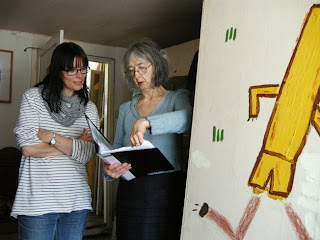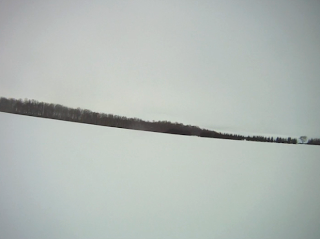Rose Wylie's studio visit was very inspiring, there was so much to look at and many topics to discuss in a wonderful, quirky and
devoted-to-art home environment at her cottage in Kent.
I discovered that Rose works obsessively, she said 'I am obsessed with my work... it's a take over' and that is clearly evident when talking to her, and looking around in her studio.
At the moment every spare space in the cottage is filled with stretched canvasses ready to ship out to exhibitions around the world, due to ever more recent interest in her work.
Rose mentioned that previously she was only known as 'an artist's wife' and not as artist in her own right. Although she has always kept up her practice over the years whilst bringing up children, it is only since they have grown up that she has been able to devote herself to her work and let it 'take over'.
The world is now waking up to this intense celebration of expressive, dramatic, playful work that has a brilliant lightness of touch, containing everyday observances form life as well as art historical references, ancient religious symbolism and scenarios from current affairs and film.
Rose's paintings are placed all around the house. In fact they are very much at home there and she would prefer that they stay there, instead of being shipped off and sold.
She talked about growing up in an era where 'blokey artists' were taken too seriously and were over sincere about their practice. She liked a bit of 'light' and humour plays an important part in her work.
Rose also hates preciousness, and she can't be accused of that herself, she stands on her work and some of her paintings are embedded with her own footprints.
In Rose's studio she asked me to help her try out some alternative faces for Penelope Cruz (taken from a scene in Pedro Almodóvar's Volver 2006). Rose is very generous with her time and giving information about what inspires her and her working methods.
She used to always paint on the floor (when more agile) and the work would stack up in piles and also be pinned to the walls, they were more like wall hangings or rugs than paintings. She finds it bothersome that the art world dictates that she should attatch them to stretchers to keep them safe and make them more sale-able.
Here Rose has mixed up red paint (bottom left) which she is about to use on a new canvas. She is very daunted by beginning a new work and never knows how to start- colour first, or line?
The main content for the new piece was to include an image of her garden path. She is very precise about the visual information that she uses in a painting and she often includes text explaining what her paintings are of.
This painting is a scene from Madeinusa 2006 Directed by Claudia Llosa. Rose uses many references to film in her work, she has wealth of knowledge about all genres of film especially world cinema. Rose and her husband watch many DVDs and see it as a great way of experiencing the world.
As well as Rose's huge canvas paintings (doubles that can measure a total of up to 10 meters wide) she also paints on paper and has a large collection of small A4 sized pieces that sometimes work as preliminary sketches or as stand alone observational works. There is a series of vividly coloured fruit and vegetable water-colour paintings, as well as many pen and ink or pencil drawings.
I left the visit very excited. Rose's compulsion to work, attention to detail and intensely sweet and generous nature inspired me to want to get back to making work. Also to notice what's right there, or here, around me in my own life, and the thought that maybe there's always the chance to look forward to such a productive future!
Rose Wylie is represented by the Union Gallery:



































